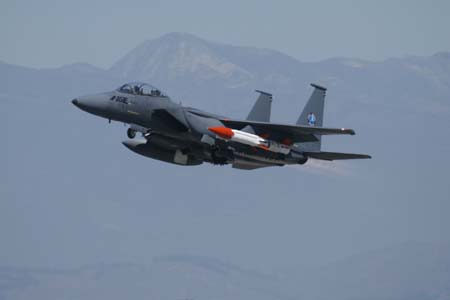After two partially successful flight demonstrations of t he full-scale hypersonic strike missile demonstrator that Boeing and Aerojet have designed under the DARPA-Navy HyFly program, DARPA announced Sept. 30 that it will fund one additional flight test to see if the missile can meet the program’s objective of reaching Mach 6 and sustaining that speed. Boeing acknowledged receipt of an $18.3 million contract two days later to cover the costs of the extra flight, which is scheduled for the summer of 2010. The decision to go with the additional flight test comes after the first two tests yielded valuable data, but didn’t exercise the missile’s dual-combustion ramjet engine as hoped. During the first test in September 2007, an engine throttle software error prevented the missile from accelerating as planned. In the second trial in January, the DCR failed to light due to a fuel-system malfunction unrelated to the engine itself, DARPA said. Both tests took place at the Navy’s test range at Point Mugu, Calif., with the missiles launched from an F-15E. Carl Avila, Boeing’s director of Advanced Weapons and Missile Systems, said HyFly’s success would “be a major step” in the development of weapon systems that “could revolutionize the military’s ability to respond rapidly to time-critical threats hundreds of miles away.” The Air Force is also pursuing hypersonic missiles and propulsion for future aircraft. Under the X-51 program with Boeing, the service aims to validate hypersonic flight capability with an unmanned, supersonic ramjet-powered air vehicle.Darryl Davis, president of Boeing’s Advanced Systems unit, said last month the company is assembling the first X-51 flight vehicle and anticipates the first X-51 flight in 2009 or early 2010.
he full-scale hypersonic strike missile demonstrator that Boeing and Aerojet have designed under the DARPA-Navy HyFly program, DARPA announced Sept. 30 that it will fund one additional flight test to see if the missile can meet the program’s objective of reaching Mach 6 and sustaining that speed. Boeing acknowledged receipt of an $18.3 million contract two days later to cover the costs of the extra flight, which is scheduled for the summer of 2010. The decision to go with the additional flight test comes after the first two tests yielded valuable data, but didn’t exercise the missile’s dual-combustion ramjet engine as hoped. During the first test in September 2007, an engine throttle software error prevented the missile from accelerating as planned. In the second trial in January, the DCR failed to light due to a fuel-system malfunction unrelated to the engine itself, DARPA said. Both tests took place at the Navy’s test range at Point Mugu, Calif., with the missiles launched from an F-15E. Carl Avila, Boeing’s director of Advanced Weapons and Missile Systems, said HyFly’s success would “be a major step” in the development of weapon systems that “could revolutionize the military’s ability to respond rapidly to time-critical threats hundreds of miles away.” The Air Force is also pursuing hypersonic missiles and propulsion for future aircraft. Under the X-51 program with Boeing, the service aims to validate hypersonic flight capability with an unmanned, supersonic ramjet-powered air vehicle.Darryl Davis, president of Boeing’s Advanced Systems unit, said last month the company is assembling the first X-51 flight vehicle and anticipates the first X-51 flight in 2009 or early 2010.
The Air Force is requesting about $141 million for initial enlistment bonuses in its fiscal 2026 budget, while Space Force wants $13 million.
